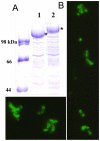Development of an HIV-1 specific microbicide using Caulobacter crescentus S-layer mediated display of CD4 and MIP1alpha
- PMID: 20442778
- PMCID: PMC2860990
- DOI: 10.1371/journal.pone.0010366
Development of an HIV-1 specific microbicide using Caulobacter crescentus S-layer mediated display of CD4 and MIP1alpha
Abstract
The development of alternative strategies to prevent HIV infection is a global public health priority. Initial efforts in anti-HIV microbicide development have met with poor success as the strategies have relied on a non-specific mechanism of action. Here, we report the development of a microbicide aimed at specifically blocking HIV entry by displaying molecular components of the HIV/host cell attachment complex on the surface of Caulobacter crescentus, a harmless aquatic bacterium. This bacterium can be readily manipulated to present heterologous proteins at high density on its surface by genetic insertion into its crystalline surface layer protein. In separate constructions, we generated bacteria displaying domain 1 of CD4 and MIP1alpha. Each moiety reacted with specific antibodies by Western immunoblot and immuno-fluorescence microscopy. Microbicide functionality was assessed using an HIV pseudotype virus assay system representing Clade B subtypes. Bacteria displaying MIP1alpha reduced infectivity by 35-78% depending on the specific subtype while CD4 display reduced infection by as much as 56%. Combinations of both constructs reduced infectivity by nearly 98%. We demonstrated that HIV infection could be inhibited using a strategy aimed at HIV-specific molecular interactions with Caulobacter surface protein display, and that sufficient protein folding and conformation could be mimicked to bind and block entry. Further, this is the first demonstration that Caulobacter surface protein display may be a useful approach to preventing HIV infection or other viruses as a microbicide. We propose that this harmless bacterium, which is inexpensive to produce and formulate, might be suitable for topical applications as a viable alternative in the search for effective microbicides to counteract the world wide incidence of HIV infection.
Conflict of interest statement
Figures






Similar articles
-
A Caulobacter crescentus Microbicide Protects from Vaginal Infection with HIV-1JR-CSF in Humanized Bone Marrow-Liver-Thymus Mice.J Virol. 2019 Aug 28;93(18):e00614-19. doi: 10.1128/JVI.00614-19. Print 2019 Sep 15. J Virol. 2019. PMID: 31243127 Free PMC article.
-
Enhanced neutralization of HIV by antibodies displayed on the S-layer of Caulobacter crescentus.Antimicrob Agents Chemother. 2011 Dec;55(12):5547-52. doi: 10.1128/AAC.00509-11. Epub 2011 Sep 6. Antimicrob Agents Chemother. 2011. PMID: 21896905 Free PMC article.
-
Development of an HIV-1 Microbicide Based on Caulobacter crescentus: Blocking Infection by High-Density Display of Virus Entry Inhibitors.PLoS One. 2013 Jun 19;8(6):e65965. doi: 10.1371/journal.pone.0065965. Print 2013. PLoS One. 2013. PMID: 23840383 Free PMC article.
-
Clinical development of microbicides for the prevention of HIV infection.Curr Pharm Des. 2004;10(3):315-36. doi: 10.2174/1381612043386374. Curr Pharm Des. 2004. PMID: 14754390 Review.
-
Past, present, and future of entry inhibitors as HIV microbicides.Curr HIV Res. 2012 Jan 1;10(1):19-26. doi: 10.2174/157016212799304616. Curr HIV Res. 2012. PMID: 22264042 Review.
Cited by
-
Analysis of the intact surface layer of Caulobacter crescentus by cryo-electron tomography.J Bacteriol. 2010 Nov;192(22):5855-65. doi: 10.1128/JB.00747-10. Epub 2010 Sep 10. J Bacteriol. 2010. PMID: 20833802 Free PMC article.
-
A Caulobacter crescentus Microbicide Protects from Vaginal Infection with HIV-1JR-CSF in Humanized Bone Marrow-Liver-Thymus Mice.J Virol. 2019 Aug 28;93(18):e00614-19. doi: 10.1128/JVI.00614-19. Print 2019 Sep 15. J Virol. 2019. PMID: 31243127 Free PMC article.
-
Enhanced neutralization of HIV by antibodies displayed on the S-layer of Caulobacter crescentus.Antimicrob Agents Chemother. 2011 Dec;55(12):5547-52. doi: 10.1128/AAC.00509-11. Epub 2011 Sep 6. Antimicrob Agents Chemother. 2011. PMID: 21896905 Free PMC article.
-
Development of an HIV-1 Microbicide Based on Caulobacter crescentus: Blocking Infection by High-Density Display of Virus Entry Inhibitors.PLoS One. 2013 Jun 19;8(6):e65965. doi: 10.1371/journal.pone.0065965. Print 2013. PLoS One. 2013. PMID: 23840383 Free PMC article.
-
Outer Membrane Vesicles from Caulobacter crescentus: A Platform for Recombinant Antigen Presentation.ACS Nano. 2025 Jun 10;19(22):20526-20538. doi: 10.1021/acsnano.4c17885. Epub 2025 May 28. ACS Nano. 2025. PMID: 40434063 Free PMC article.
References
-
- UNAIDS. 2008 Report on the Global AIDS Epidemic: UNAIDS 2008.
-
- Asimwe-Okiror G, Kufa E, Ntabangana S, Alisalad A, Garcia C, J. M. HIV/AIDS Epidemeological Surveillance Report for the WHO African Region 2007 Update. 2007. World Health Organization Regional Office for Africa.
-
- Harrison PF, Rosenberg Z, Bowcut J. Topical Microbicides for Disease Prevention: Status and Challenges. Clinical Infectious Diseases. 2003;36:1290–1294. - PubMed
Publication types
MeSH terms
Substances
LinkOut - more resources
Full Text Sources
Other Literature Sources
Medical
Research Materials
Miscellaneous

